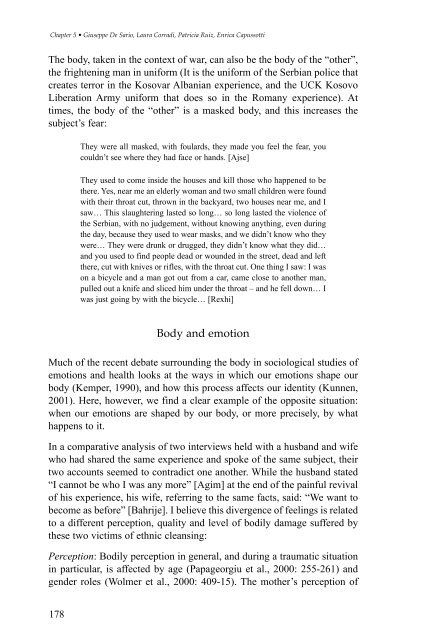Psychosocial Notebook - IOM Publications - International ...
Psychosocial Notebook - IOM Publications - International ...
Psychosocial Notebook - IOM Publications - International ...
Create successful ePaper yourself
Turn your PDF publications into a flip-book with our unique Google optimized e-Paper software.
Chapter 5 • Giuseppe De Sario, Laura Corradi, Patricia Ruiz, Enrica Capussotti<br />
The body, taken in the context of war, can also be the body of the “other”,<br />
the frightening man in uniform (It is the uniform of the Serbian police that<br />
creates terror in the Kosovar Albanian experience, and the UCK Kosovo<br />
Liberation Army uniform that does so in the Romany experience). At<br />
times, the body of the “other” is a masked body, and this increases the<br />
subject’s fear:<br />
They were all masked, with foulards, they made you feel the fear, you<br />
couldn’t see where they had face or hands. [Ajse]<br />
They used to come inside the houses and kill those who happened to be<br />
there. Yes, near me an elderly woman and two small children were found<br />
with their throat cut, thrown in the backyard, two houses near me, and I<br />
saw… This slaughtering lasted so long… so long lasted the violence of<br />
the Serbian, with no judgement, without knowing anything, even during<br />
the day, because they used to wear masks, and we didn’t know who they<br />
were… They were drunk or drugged, they didn’t know what they did…<br />
and you used to find people dead or wounded in the street, dead and left<br />
there, cut with knives or rifles, with the throat cut. One thing I saw: I was<br />
on a bicycle and a man got out from a car, came close to another man,<br />
pulled out a knife and sliced him under the throat – and he fell down… I<br />
was just going by with the bicycle… [Rexhi]<br />
Body and emotion<br />
Much of the recent debate surrounding the body in sociological studies of<br />
emotions and health looks at the ways in which our emotions shape our<br />
body (Kemper, 1990), and how this process affects our identity (Kunnen,<br />
2001). Here, however, we find a clear example of the opposite situation:<br />
when our emotions are shaped by our body, or more precisely, by what<br />
happens to it.<br />
In a comparative analysis of two interviews held with a husband and wife<br />
who had shared the same experience and spoke of the same subject, their<br />
two accounts seemed to contradict one another. While the husband stated<br />
“I cannot be who I was any more” [Agim] at the end of the painful revival<br />
of his experience, his wife, referring to the same facts, said: “We want to<br />
become as before” [Bahrije]. I believe this divergence of feelings is related<br />
to a different perception, quality and level of bodily damage suffered by<br />
these two victims of ethnic cleansing:<br />
Perception: Bodily perception in general, and during a traumatic situation<br />
in particular, is affected by age (Papageorgiu et al., 2000: 255-261) and<br />
gender roles (Wolmer et al., 2000: 409-15). The mother’s perception of<br />
178

















